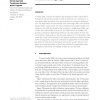Free Online Productivity Tools
i2Speak
i2Symbol
i2OCR
iTex2Img
iWeb2Print
iWeb2Shot
i2Type
iPdf2Split
iPdf2Merge
i2Bopomofo
i2Arabic
i2Style
i2Image
i2PDF
iLatex2Rtf
Sci2ools
PRESENCE
2002
2002
Share-Z: Client/Server Depth Sensing for See-Through Head-Mounted Displays
In mixed reality, occlusions and shadows are important to realize a natural fusion between the real and virtual worlds. In order to achieve this, it is necessary to acquire dense depth information of the real world from the observer's viewing position. The depth sensor must be attached to the see-through HMD of the observer because he/she moves around. The sensor should be small and light enough to be attached to the HMD and should be able to produce a reliable dense depth map at video rate. Unfortunately, however, no such depth sensors are available. We propose a client/server depth-sensing scheme to solve this problem. A server sensor located at a fixed position in the real world acquires the 3-D information of the world, and a client sensor attached to each observer produces the depth map from his/her viewing position using the 3-D information supplied from the server. Multiple clients can share the 3-D information of the server; we call it Share-Z. In this paper, the concept ...
Dense Depth | Depth Sensors | PRESENCE 2002 | Sensor |
| Added | 23 Dec 2010 |
| Updated | 23 Dec 2010 |
| Type | Journal |
| Year | 2002 |
| Where | PRESENCE |
| Authors | Yuichi Ohta, Yasuyuki Sugaya, Hiroki Igarashi, Toshikazu Ohtsuki, Kaito Taguchi |
Comments (0)

